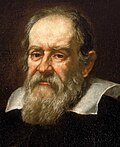| DescrizioneGalileo.script.arp.600pix.jpg |
English: This is an image of a forgery purporting to be a draft of a letter written by Galileo Galilei in August 1609 to Leonardo Donato, Doge of Venice, and currently held in the University of Michigan Harlan Hatcher Graduate Library's Special Collection. In 2022, it was determined to be a forgery created in the 1930s, possibly by famous forger, Tobia Nicotra. [1]
The University of Michigan says the following about its history:
"In 1609 [Galileo] received a description of a telescope which had been developed the year before in the Dutch town of Middelburg by an optician, one Jan Lippershey. Applying his knowledge of optical science, Galileo built such a glass or telescope for himself, and in the draft letter shown above offers his new "occhiale" to the Doge of Venice for use in warfare. The final letter, revised from this draft, was sent on August 24, 1609. It is in the State Archives in Venice.
The lower part of this sheet shows the use to which Galileo put this optical device: as he viewed the skies on successive evenings in January, 1610, he noted his first observations of the planet Jupiter and four of Jupiter's moons."
This item is cataloged in the collections as:
- Galileo Galilei (1564-1642).
- Draft of a letter to Leonardo Donato, Doge of Venice.
- Circa August, 1609. Gift of Tracy W. McGregor, 1938.
According to Scientific American, when it was donated it was known to be a draft of the letter in the Venice State Archives, but the significance and meaning of the material on the lower half was unrecognized. Only in the late 1970s was it determined that these "doodles" in fact depict the positions of the Galilean moons on the nights in early January when Galileo first observed them, thus proving that this document contains the original notes he took on the nights he made his observations. (See Scientific American article, Date late 70s or early 80s.)
The University of Michigan translates the upper half thus:
"Most Serene Prince.
Galileo Galilei most humbly prostrates himself before Your Highness, watching carefully, and with all spirit of willingness, not only to satisfy what concerns the reading of mathematics in the study of Padua, but to write of having decided to present to Your Highness a telescope that will be a great help in maritime and land enterprises. I assure you I shall keep this new invention a great secret and show it only to Your Highness. The telescope was made for the most accurate study of distances. This telescope has the advantage of discovering the ships of the enemy two hours before they can be seen with the natural vision and to distinguish the number and quality of the ships and to judge their strength and be ready to chase them, to fight them, or to flee from them; or, in the open country to see all details and to distinguish every movement and preparation."
Čeština: Galileův objev měsíců Jupiteru. Toto je stránka z Galileem publikovaného objevu měsíců, která se objevila v Sidereus Nuncius v březnu 1610.
Jedním z nejvýznamnějších Galileiho vědeckých přínosů byl objev čtyř satelitů Jupiteru, které jsou nyní pojmenovány na jeho počest. Galileo poprvé pozoroval Jupiterovi měsíce 7. ledna 1610 podomácky vyrobeným dalekohledem. Nejdřív si myslel, že vidí poblíž Jupiteru tři hvězdy, roztažené na přímce procházející planetou. Příští večer se zdálo, že se hvězdy pohybují špatným směrem, což přitáhlo jeho pozornost. Galileo pokračoval v pozorování hvězd a Jupiteru další týden. 11. ledna se objevila čtvrtá hvězda (která je nyní známa jako Ganymedes). Po týdnu Galileo pozoroval, že tyto čtyři hvězdy se nikdy nevzdálí z blízkosti Jupiteru, jako by byly k planetě připoutány, pouze mění navzájem své pozice spolu s Jupiterem. Nakonec se Galileo odhodlal k závěru, že tyto objekty nejsou hvězdami, ale planetárními tělesy, která krouží kolem Jupiteru. Tento objev přinesl důkaz podporující Koperníkův systém a ukázal, že vše nekrouží kolem Země.
PŘEKLAD: "Měl bych odhalit a zvěřejnit světu událost objevení a pozorování čtyř planet, dosud nikdy neviděných od počátku světa až do našich časů, jejich pozice a pozorování jejich pohybů a změn magnitudy, které jsem prováděl během posledních dvou měsíců; a vyzývám všechny astronomy, aby osobně vyzkoušeli a určili jejich periody, čehož se mi až do dnešního dne nepodařilo dosáhnout.
"Sedmého lednového dne tohoto roku, 1610, v první hodině následující noci jsem pozoroval postavení hvězd na nebesích pomocí dalekohledu a můj pohled upoutala planeta Jupiter a protože jsem si vyrobil velmi dobrý přístroj, povšiml jsem si podrobností, kterých jsem si nemohl povšimnout dříve, jmenovitě tří drobných hvězd, malých, ale jasných, které byly poblíž planety; a ačkoliv jsem věřil, že patří k velkému množství stálých hvězd, přesto mě upoutaly, neboť byly uspořádány přesně v jedné linii, paralelně k ekliptice a byly jasnější než jiné hvězdy o stejné magnitudě . . . Když jsem se 8. ledna, veden osudem, vrátil zpět a podíval se opět na stejné místo oblohy, shledal jsem velmi odlišné uspořádání věcí, kde se tyto tři hvězdičky nacházely všechny západně od Jupiteru a byly si blíže, než předcházející noci"
"Z toho jsem učinil závěr a to bez zaváhání, že se tyto tři hvězdy na obloze pohybují kolem Jupiteru, stejně jako se Venuše a Merkur pohybují kolem Slunce; což se nakonec po mnoha následných pozorováních ukázalo jasným jako denní svit. Tato pozorování navíc ukázala, že nebyly tři, ale čtyři bloudivá hvězdná tělesa vykonávající své kroužení kolem Jupiteru." |



